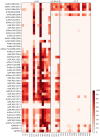Glycosylation changes in the globular head of H3N2 influenza hemagglutinin modulate receptor binding without affecting virus virulence
- PMID: 27796371
- PMCID: PMC5086918
- DOI: 10.1038/srep36216
Glycosylation changes in the globular head of H3N2 influenza hemagglutinin modulate receptor binding without affecting virus virulence
Abstract
Since the emergence of human H3N2 influenza A viruses in the pandemic of 1968, these viruses have become established as strains of moderate severity. A decline in virulence has been accompanied by glycan accumulation on the hemagglutinin globular head, and hemagglutinin receptor binding has changed from recognition of a broad spectrum of glycan receptors to a narrower spectrum. The relationship between increased glycosylation, binding changes, and reduction in H3N2 virulence is not clear. We evaluated the effect of hemagglutinin glycosylation on receptor binding and virulence of engineered H3N2 viruses. We demonstrate that low-binding virus is as virulent as higher binding counterparts, suggesting that H3N2 infection does not require either recognition of a wide variety of, or high avidity binding to, receptors. Among the few glycans recognized with low-binding virus, there were two structures that were bound by the vast majority of H3N2 viruses isolated between 1968 and 2012. We suggest that these two structures support physiologically relevant binding of H3N2 hemagglutinin and that this physiologically relevant binding has not changed since the 1968 pandemic. Therefore binding changes did not contribute to reduced severity of seasonal H3N2 viruses. This work will help direct the search for factors enhancing influenza virulence.
Figures








References
-
- Reichert T. A. et al.. Influenza and the winter increase in mortality in the United States, 1959–1999. Am. J. Epidemiol. 160, 492–502 (2004). - PubMed
-
- Suzuki Y. Positive selection for gains of N-linked glycosylation sites in hemagglutinin during evolution of H3N2 human influenza A virus. Genes Genet. Syst. 86, 287–294 (2011). - PubMed
Publication types
MeSH terms
Substances
Grants and funding
LinkOut - more resources
Full Text Sources
Other Literature Sources

